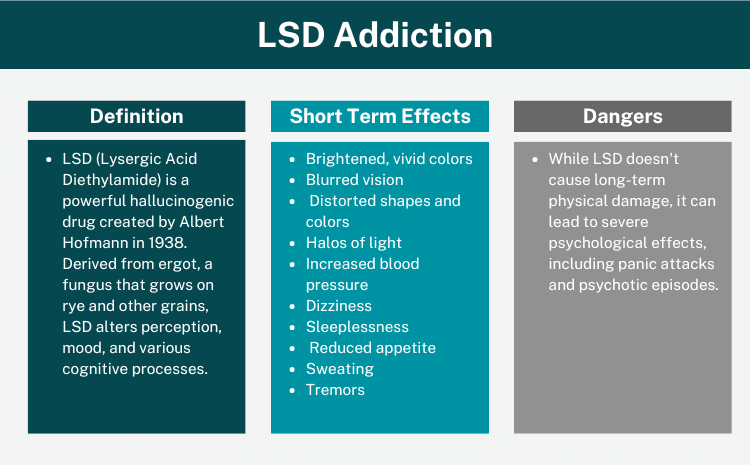LSD Addiction: Symptoms, Risks, and Recovery
LSD, also known as lysergic acid diethylamide, is a powerful hallucinogenic drug. It was first created by Albert Hofmann, a Swiss scientist, in 1938. He was studying a chemical found in ergot, a fungus that grows on rye and other grains.
Hofmann didn’t know what he had stumbled upon until 1943, when he accidentally ingested a small amount and experienced vivid, colorful hallucinations. A few days later, he took a larger dose and embarked on the first intentional acid trip while riding his bicycle home from work.
Over the years, LSD became a symbol of the 1960s counterculture. Despite its early promise for medical research, it became more known for its unpredictable effects and potential for abuse.
In this article, we’ll explore the symptoms and risks of LSD addiction and discuss the recovery process for those struggling with this powerful drug.

What Is Lysergic Acid Diethylamide (LSD)?
LSD, short for lysergic acid diethylamide , is a powerful hallucinogenic drug. It belongs to a group of substances known as psychedelics. This synthetic chemical is derived from ergot, a type of fungus that infects rye and other grains.
On the street, LSD is known by many names, including Acid, Blotter Acid, Dots, Mellow Yellow, and Window Pane. It’s important to know these names because what is sold as LSD can sometimes be other, more dangerous chemicals. These substitutes can be very inconsistent in quality and, in some cases, fatal if taken in large amounts.
In its pure form, LSD is a white, odorless crystalline substance. However, because it’s so potent, even a tiny dose is almost invisible. This is why LSD is usually mixed with other materials. It’s commonly found as drops of LSD solution dried onto gelatin sheets, pieces of blotting paper, or sugar cubes, which release the drug when swallowed. Sometimes, it’s sold as a liquid, in tablets, or in capsules.
When someone takes LSD, the effects can vary greatly depending on the dose. Small amounts might cause mild changes in perception, mood, and thought. Larger doses can lead to intense visual hallucinations and distortions of time and space. This can make the drug unpredictable and risky. Understanding these effects is key to recognizing the symptoms and risks associated with LSD addiction, which we will explore further in this article.
Physical and Psychological Effects of LSD
LSD side effects on both the body and mind can be very diverse. These effects can vary greatly depending on the dosage, the individual’s mindset, and their environment when taking the drug.
Effects on Perception
LSD significantly alters perception, affecting vision, touch, emotions, and thinking. Visual effects can include:
- Brightened, vivid colors
- Blurred vision
- Distorted shapes and colors of objects and faces
- Halos of light
Changes related to touch might include shaking, pressure, and lightheadedness. Mood changes are also common and can range from euphoria and bliss to despair and confusion. People might experience rapid mood swings and a distorted sense of time, feeling like it is moving very fast or very slow.
Short-Term Physical Effects
Using LSD can stimulate the body, leading to an increase in blood pressure, heart rate, and body temperature. Other short-term physical effects include:
- Dizziness
- Sleeplessness
- Reduced appetite
- Dry mouth
- Sweating
- Numbness
- Weakness
- Tremors
Psychological Effects
The psychological effects of LSD are particularly profound. They can include accelerated thoughts, unusual insights, or terrifying thoughts. Some people feel a sense of transcendence or a deep connection with the universe. However, the experience can also be extremely frightening, potentially leading to panic attacks, psychotic episodes, and intense paranoia.
The unpredictability of an LSD “trip” is one of its most dangerous aspects. A “good trip” can lead to feelings of well-being and creativity, while a “bad trip” can feel like a nightmare, filled with fear and a sense of losing control.
LSD Usage Methods and Dosage Information
LSD is typically used in doses ranging from 100 to 150 micrograms. Its effects can last up to 12 hours, although its half-life is about 3 hours.
On the street, LSD appears in various forms. The most common is blotter paper, where LSD is soaked onto absorbent sheets with colorful designs. Other forms include thin squares of gelatin, small tablets called Microdots, capsules, liquid on sugar cubes, and pure liquid form.
Some users may snort or inject LSD, though this is less common. Because the potency can vary widely, it’s hard to predict the exact amount of LSD in any given form.
Is LSD Dangerous?
LSD doesn’t cause long-term physical damage, but it can be risky. During a bad trip, people might harm themselves, so those feeling down or anxious should avoid it.
However, If you have mental health issues or a family history of them, LSD can worsen these conditions. A bad trip can feel like your worst nightmare, causing panic and confusion. For some, LSD might trigger underlying mental health problems, leading to long-term issues. Flashbacks, or ongoing visual distortions known as Hallucinogen Persisting Perception Disorder (HPPD), can also occur, causing significant distress.
Additionally, mixing LSD with other drugs can be dangerous. Here’s how it interacts with some common substances:
- Marijuana: Combining LSD with marijuana can intensify hallucinations and emotional reactions. This mix can lead to heightened anxiety, paranoia, and panic attacks.
- Cocaine: Mixing cocaine and LSD is risky. Cocaine is a stimulant, which can increase heart rate and blood pressure. Combined with LSD, this can cause severe cardiovascular stress and unpredictable mental effects.
- Alcohol: Drinking alcohol while on LSD can dull the hallucinogenic effects, but it also impairs judgment and coordination. This combination increases the risk of accidents and risky behavior.
- Opioids: Using opioids with LSD is particularly dangerous. Opioids can depress the central nervous system, while LSD stimulates it. This conflicting combination can lead to severe physical and mental health issues, including an overdose.
Every time you mix drugs, you increase your risk. Even though LSD itself isn’t usually mixed with other substances, combining it with other drugs can be unpredictable and hazardous. It is essential to be aware of these dangers to make informed decisions about drug use.
The Risk of LSD Overdose
While LSD itself isn’t typically lethal, its indirect effects can be dangerous. During a bad trip, individuals may become unaware of their actions, leading to severe injury or even death. Accidents, self-harm, and suicide have been reported during these intense episodes. The unpredictable nature of LSD trips makes it crucial to understand the risks involved with higher doses.
What Is LSD Addiction?
LSD is generally considered non-addictive physically, but it can lead to a strong psychological addiction. Many users become addicted to the vivid hallucinations and altered perceptions it provides. These experiences can make people feel as though they have had deep revelations about life, which can be highly compelling.
While LSD doesn’t create a physical dependence, regular use can result in a behavioral addiction. Users often crave the drug for its mind-altering effects. This psychological addiction can lead to frequent use, which increases the risk of flashbacks and long-term mental health issues.
Over time, users can build up a tolerance to LSD, meaning they need larger doses to achieve the same effects. This is dangerous as it increases the risk of toxicity and overdose. It also heightens the chance of injury due to impaired judgment while under the influence.
Short-Term Effects of Cocaine Use
Several biological factors contribute to LSD addiction, mainly involving the brain’s dopamine and serotonin systems.
LSD can stimulate the brain’s reward system, particularly the mesolimbic dopamine pathway, leading to feelings of pleasure. Although LSD primarily affects serotonin receptors, it can also influence dopamine levels, enhancing the sense of reward.
LSD acts on the serotonin (5-HT) receptors, especially 5-HT2A receptors, altering perception, mood, and cognition. The changes in mood and perception can make users crave these altered states, contributing to psychological dependence.
Repeated LSD use can change synaptic plasticity, affecting learning and memory. This creates strong associations between the drug and certain experiences, reinforcing the desire to use it. Over time, cues associated with LSD use can trigger cravings and psychological dependence.
The prefrontal cortex, which handles decision-making and self-control, is also affected by LSD. The drug impairs judgment, making it harder for individuals to resist the urge to use it. Additionally, LSD can make drug-related cues more noticeable, increasing the likelihood of repeated use.
Understanding these processes can help in recognizing and addressing LSD addiction.
LSD Addiction Treatment
Treating LSD addiction involves various options, depending on the individual’s needs. For those abusing multiple drugs, with underlying medical or psychiatric conditions, or with a long history of drug use, an inpatient program might be necessary. The severity of drug abuse and previous unsuccessful outpatient treatments are also considered.
Inpatient rehab programs require patients to live at the facility full-time for 30 to 90 days. This intensive environment allows individuals to focus entirely on recovery, with support from clinicians, staff, and fellow patients.
Not everyone needs inpatient care. Many people opt for outpatient programs, which vary in duration and intensity. These programs can last 3-6 months, with treatment sessions ranging from once a week to multiple times per week, each lasting 1 to 4 hours.
Methods used to treat LSD abuse
Cognitive-behavioral therapy (CBT) is the most common treatment for drug abuse. It helps change thinking patterns that lead to substance abuse, teaching new ways to manage stress and triggers without using drugs.
Motivational interviewing (MI) is another approach. It’s used when individuals aren’t fully ready to quit drugs. This method evaluates a person’s readiness to change and addresses personal barriers. The goal is to move them from resistance to a desire for change and, eventually, to taking action.
No matter which drugs are abused, professional rehab programs can help individuals achieve sobriety and develop strategies to prevent relapse.
Taking the First Steps Toward Recovery
If you or someone you love is struggling with addiction to LSD, other drugs, or alcohol, effective treatment is available to help you get on the road to recovery. Comprehensive, evidence-based healthcare programs are designed to help individuals overcome substance use disorders and achieve the life they deserve. Don’t hesitate to reach out and take the first step toward a healthier, happier future.
